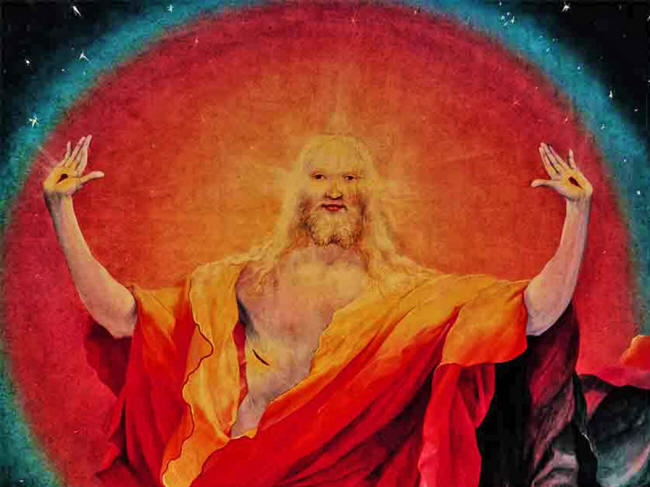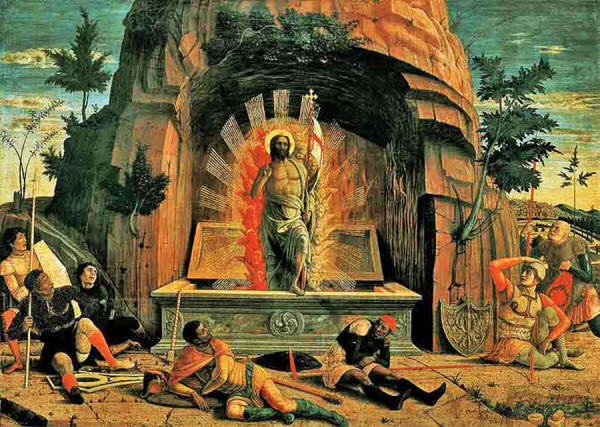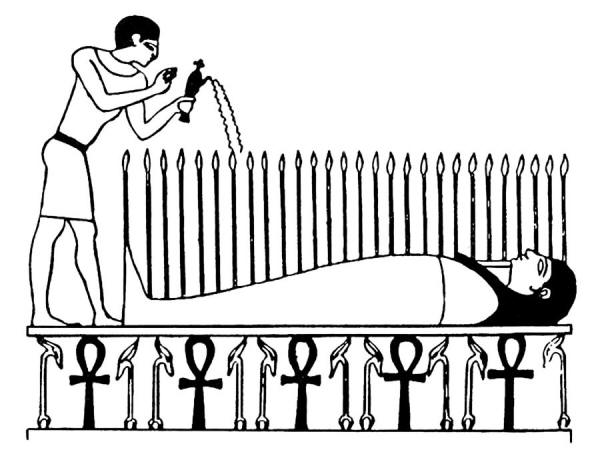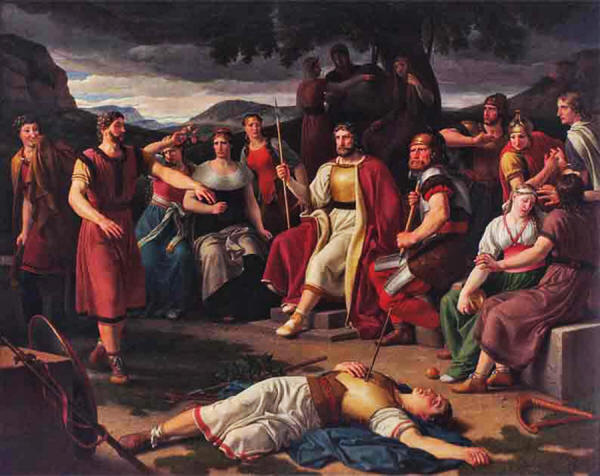|

by Historic Mystery
April 12, 2024
from
HistoricMysteries Website

Many religions across
the ancient world
had a resurrected
god, and their presence and purpose
tells us something
fundamental about religion itself.
Source: Txllxt TxllxT
/ CC BY-SA 4.0.
The key moment in
Christianity is Jesus's death on
the cross...
From this "sacrifice" the son of
God returns after three days,
come back to life to reassure the mourning
disciples that everything will be fine.
He gives them tasks, and then heads off to
heaven for ever (or for the moment, anyway).
Taken in isolation, this is a strange sequence of
events.
Sacrifice is one thing, but this sacrifice is
undone within a matter of days.
Coming back from the dead is also pretty
momentous, but Christ appears to only a handful of people before
disappearing semi-permanently.
Might as well have not come back at all, you
might think.
There is a reason for this, however.
The death and resurrection of
Christ is an aspect of religion left over from a much older way of
thinking.
Once we know what to look for, we see dead and resurrected
gods everywhere in the ancient world.
And what this repeated story can tell us about the cultures in which
it appears gets to the very core of what religion is.
Put simply,
religion is an attempt to explain what its followers observe but
cannot explain, somewhere between metaphor and protoscience.

Christ is perhaps the
most familiar version
of the resurrected
god today.
(Andrea Mantegna /
Public Domain)
The motif of a dying and resurrected deity spans across various
cultures and religions, symbolizing the cyclic nature of life,
death, and rebirth.
This archetype reflects humanity's
observations of the natural world, particularly the seasonal
cycles of growth, decay, and renewal...
The motif in Christianity is a later version,
shorn if its original context and meaning but surviving as a relic
of the religions on which Christianity is founded.
Earlier Greek, Pagan, and Egyptian traditions all
had their versions.
Is it an intriguing aspect of ancient
religions?
Or is it more, is it the core of what ancient
religions were, and what religion, in and of itself, is?
Is it universal...?
Why Does Christ Come Back?
In Christianity, the death and resurrection of Jesus Christ
are central to the faith's doctrine.
Christ's crucifixion, death, and subsequent
resurrection are commemorated annually through Good Friday and
Easter, symbolizing the ultimate victory over sin and death.
Of course, for modern Christians this has nothing to do with the
cycle of nature... This narrative provides believers with hope
for eternal life, emphasizing spiritual rebirth and
the possibility of redemption.
But that isn't where it came from...
The rebirth of a dead god at Easter time,
traditionally the moment in a lot of the
world when crops start to grow, is an anthropomorphized
explanation of the cycle of the seasons.
The dead world comes back to life in the spring,
and God created the world, so it makes sense that he runs on
the same schedule, and that he can bring Himself back to life
at the same time.
The modern version of the death-and-resurrection story has nothing
to do with this, of course.
Centuries of Christian orthodoxy layered on top
of the original story means it has transformed into a message about
life after death somewhere else, not here on Earth.
The abrupt departure of Jesus after his resurrection allowed
Church leaders to paint a vivid picture of where he went,
and to make extravagant promises about there...
But originally it was not about there,
it was about here...!
Death and Resurrection in Older
Traditions
Perhaps the most well-known example of the death and resurrection
story outside of Christianity, at least to those with a smattering
of classical knowledge, is that of Hades and
Persephone.
The story goes that,
the god of the underworld espied the
beautiful Persephone one day and spirited her off to the
underworld to be his bride.

Persephone,
who spends part
of the year with her mother
and part with
her husband, is another example
of the
archetype of the resurrected god
(Dante
Gabriel Rossetti / Public Domain)
In Persephone's absence her mother, Demeter, mourned.
Demeter, a goddess of fertility,
neglected her duties to the world of mortals in her grief:
crops withered, plants and animals died
away, and the very world itself started to come undone.
This worried the gods and Zeus, who knew very
well what had happened, sent a message to Hades that Persephone
should be returned to her mother.
However Persephone had, during her time
in the underworld, eaten some pomegranate, and was now
partially beholden to that place, too.
And so we have a neat explanation for the
seasons...
For part of the year Persephone is with her
mother, and everything is great:
crops grow, the weather is nice, the land
is fertile.
But when Persephone returns to the underworld
and her dark husband, the world dies once again.
Again we have
religion explaining what people saw
around them in terms they could understand.
They knew that crops grow in the springtime
and that the world grows cold and dead in the winter, but not
why.
And it looking to personify the natural cycle
they gave it a name:
Persephone.
Now you could argue that Persephone doesn't
actually die, she just goes to the underworld for part of the
year before returning to life.
But the underlying metaphor is the same, and
for the Greeks dying and going to the underworld were
essentially equivalent, rendering this point somewhat moot.
We see this in other pagan rituals, too.
Festivals such as
Beltane celebrate the themes of
fertility, renewal, and rebirth.
Beltane, which marks the beginning of summer,
is characterized by rituals that symbolize the potency of life
and the growth of the natural world.
It is the rebirth of the god Bel, dead for a
season but now back with all his life-giving power.
Fires are lit to represent the return of light
and warmth, mirroring the sun's increasing strength.
These celebrations are a direct homage to the
life-death-rebirth cycle, emphasizing the importance of seasonal
changes in the regeneration of life.

The bed of Osiris,
from which the
god is resurrected.
Looks a lot
like watering crops, doesn't it?
(E. A. Wallis
Budge / Public Domain)
We can even see the variations based on the geography of the myth's
origin.
Take the story of Isis and Osiris, for example.
Osiris, murdered by his brother Set and
dismembered, is resurrected by his wife Isis, becoming the lord
of the underworld and judge of the dead.
This is a different myth because of what the
ancient Egyptians saw around them:
their world was not primarily dependent on
seasonal changes in the weather, like the Greeks or other
European cultures.
Theirs was dependent on the Nile.
The Egyptians divided their land into two regions, the red and the
black.
The black region was the fertile area near to
the banks of the Nile, named for the color of its soil.
The red region was the unending desert that
stretched beyond.
Set was lord of the desert regions, and his
murder of his brother god represents the encroachment of the desert
into the fertile banks of the Nile during the dry season.
However the annual flooding of the Nile River, on
which Egyptians depended on for agriculture, shows Osiris coming
back to life and providing for his people.
Isis is the agent of this rebirth for similarly
straightforward reasons:
bringing new life into the world was
something only a woman can do.
Universal Construct or Cultural
Variation?
The recurring motif of a dying and resurrected god across these
diverse cultures suggests therefore a universal construct, rooted in
the human experience of observing and interpreting the natural
world.
The death-rebirth cycle reflects a
fundamental understanding of nature's rhythms and the hope for
renewal amidst decay and death.
This is a useful tool for understanding religion:
as a way to explain the world around us using
only our limited understanding of ourselves.
However, it's important to note that while this
theme is prevalent in many ancient religions, it is not universal.
In other ancient traditions, such as those in Asia and the Americas,
the conceptual framework can differ significantly.
For example,
in Hinduism, the concept of
reincarnation and the cyclical
nature of the universe (samsara) offer a different
interpretation of life, death, and rebirth.
In the Americas, Native American mythologies often focus on the
harmonious balance between nature and humanity rather than a
death-rebirth cycle.
They have their own stories, but these are based
on different observations of the world to those of the ancient near
east.

Baldr offers a warning for what
happens
when a
god is not resurrected, that is to say,
when the
seasons fail and life does not renew.
(Christoffer
Wilhelm Eckersberg / Public Domain)
But for many religions, the myth of the dying and resurrected
god serves as a profound metaphor for the cyclical
nature of life...
This motif repeats again and again across the
ancient world and across time:
Dionysus, Adonis, Marduk, Duzumi: they all
fit this pattern.
Interestingly, some religions also explore what
happens when the dead god does not come back...:
Baldr does not come back in Norse
mythology, and his death precipitates the doom of the gods.
It offers a recognition from these ancient
cultures that they lived in their lands entirely dependent on the
forces of nature they could neither fully explain, nor hope to
control.
They depended on the cycle of the seasons and the
miracle of fertility for their existence, and they called
these 'natural forces' gods...
References
|






